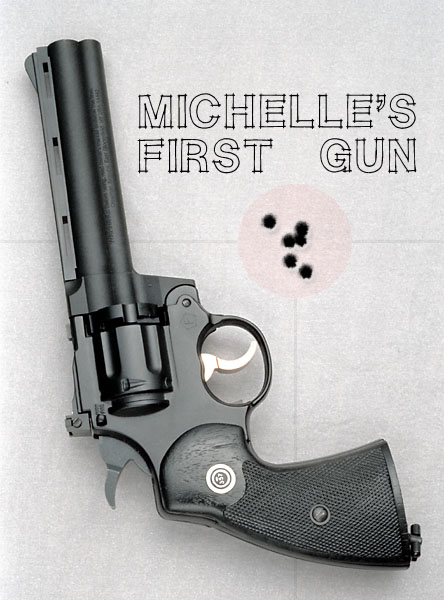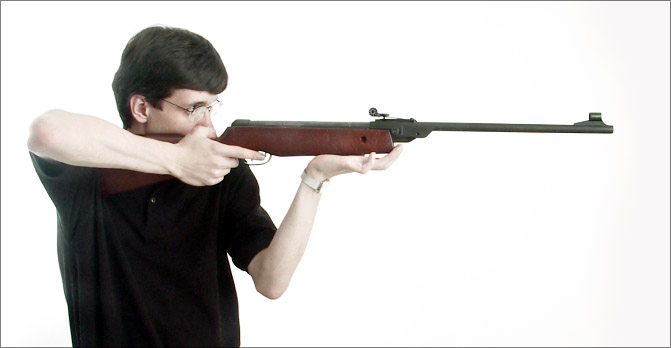
Back when I first started shooting, I acquired a CO2 Crossman air gun for my girlfriend. It turned out extremely accurate and I kept it for over a dozen years until somebody borrowed it and forgot to return it. It was recently replaced with a Umarex S&W586 copy. While air guns don’t fully duplicate the manual of arms of real weapons, they are excellent for practicing presentation, sight alignment, trigger control and other elements of marksmanship.

A few years after the revolver, I got a refurbished Daisy single-shot pellet rifle. It was very similar to the single-shot arcade rifles that I used so enthusiastically as a kid in Russia. The rifle got regular use for back-yard practice and was eventually given to a friend’s daughter. A friend gave me his scoped Gamo 880 and it got used for longer-range practice, even including a couple of rabbit retirements. But the trigger on that was not impressive and the 4x optic was outright poor. For very occasional use, I didn’t want to get anything fancier. Spring air guns in general feel like open-bolt submachine guns: the lock time is relatively slow and the balance shifts slightly on firing. Those same qualities mean that a proficient air gunner would do very well with firearms. And then the crunch came.
The crunch was two-fold: 22LR ammunition got scarce, and my time got even more scarce than that. Driving 50 minutes each way to the range became prohibitively time-consuming, so I have not got to shoot since my late May training in Switzerland. Something had to change. I can shoot air guns legally very close to my home, while even suppressed 22s require either traveling to the far range or asking neighbors for access to farm properties.
I solved the problem by getting a RWS Diana 34P Compact. It came with a parallax-adjustable 3-9x scope of very good clarity. The ability to adjust parallax is important because of the short distances at which air guns are normally used. My past practice was done at 10 to 20 yards, and I don’t expect to go much past 50 at most. While I looked into pre-charged models, that would require more support structure than I wanted to maintain. The only expense with with the spring or gas pistol pellet guns is the ammunition.
I have not tried difference kinds of pellets with the new gun yet. Gamo 880 gave good results with the cheapest flat point Daisy pellets but was all over the place with pointed Crossmans. In general, it’s a good idea to try different types to see what works best for you — .177 pellet guns are even more picky than 22LR rifles. Some companies offer variety packs just for that. The prices, especially now, are very good — from ONE cents per pellet to about eight for the high-end match projectiles. And they are all in stock.
The new rifle has certain advantages over the old Gamo. It’s more ergonomic, produces higher velocities, and has a far better trigger. Daisy and Gamo both were like bad Mosin triggers, heavy and spongy. The RWS trigger is more like a decent Mauser trigger. The thick muzzle provides a comfortable grip for cocking the spring. It is more expensive than the Walmart specials, but the accuracy and the longevity are much improved. And the savings in ammunition and time not spent driving to distant ranges should be worth the one-time expense.




Great post! I’ve had a Benjamin for years, but it wasn’t until recently I pulled it out of the closet to start shooting again. We had a bad woodchuck problem in the yard, and relocating them isn’t an option. Too many close neighbors for a .22 (I don’t have a can and I didn’t want to try shorts in my S&W 15-22) so I broke out the old rifle and got a scope mount and decent scope for it.
The woodchucks are no longer a problem, but I think I’m going to keep shooting the rifle in the back yard. Full stretch is about 50 yards with some good woods to the next neighbor. Only issue is I have a multi-pump and it’s zeroed for 7 pumps which gets tiring fast. Michigan won’t let you order a rifle shipped to your house, so I think I have to have a gun shop order me a nice break rifle like the one you posted. My Benjamin needs some work to get the scope set to the right eye relief, and I’d have to do a pretty big cheek riser to meet up to it properly.
I have a Benjamin Nitro in .25 cal with the 3-9X scope on it. I’m still learning the artillery hold, and I fully expect it will be a great small varmint rifle on my farm in TN this fall. That .25 pellet at about 900 fps /should/ take care of pests up to groundhog size, and may even put some meat on the table . I’m not thrilled with the trigger, but I hear there’s a drop-in upgrade that can be had for about $30; that’s next on the list…
Ross – you might get some of that foam “swimming pool noodle” stuff and cut it in half lengthwise for a cheap cheek riser. You can attach it to your stock with camo ankle-wrap take available at Tractor Supply and not permanently mess up your stock while you’re getting it set the way you want it.
Cheers,
Rob
Oleg,
You’ve apparently rediscovered what competitive shooters have known for the last century: that marksmanship is a maintained skill, with the basic principles of proper position/grip, sight alignment and sight picture (physics), trigger control, and follow-through being universal, as well as fundamental. As a competitive marksman (Distinguished #1130), I noticed that the best competitors in Minnesota shot small bore in the wintertime, here, in Minnesota. I also noticed that a lot of High Power Rifle competitors could NOT shoot small bore, but that every decent small bore shooter could shoot High Power. The good air gunners were the best, always.
The issue is “barrel time” and trigger control/follow-through. With fast High Power bullets, the High Power competitor can get by with a “controlled flinch,” sometimes. The .22 shooter cannot, because any lack of precise follow-through happens while the bullet is still in the barrel. This is further accentuated with air rifles. Just look at the velocities (for heavier, longer range bullets): HP, 2,550 – 2,800; SB, 1,090 (Match), 1,130 (SV), 1,250 (HV); Air, 600 (10 meter) – 900 (field target power). There’s the story in a nutshell. If you jerk the trigger and do not follow through, you won’t hit what you’re aiming at, because the firearm is pointing in a different place when the projectile leaves the barrel.
Therefore, Oleg, not only will you maintain proficiency using air guns, you will also increase it. And that’s the reason that I do most of my shooting, these days, with an old .22 (Remington Model 34, bolt action, tubular feed, 24″ barrel, last made in 1938 – with a receiver peep sight and its front post, it is stunningly accurate at 50 yards with standard velocity and 75 yards with high velocity, same sight setting), some 2,500 to 3,000 rounds per year (more or less) for the last 35 years. That’s the plinking part. For serious, meticulous, challenging work, I turn to my match rifles which can deliver shots into the same ragged hole, time after time, if I do my part. If I’m feeling especially masochistic, I’ll take out my Anschutz 2002 PCP air rifle in .177, which is, by far, the most accurate rifle that I own. The trigger is measured in ounces, the uniform velocity makes you think that the chronograph isn’t working (of 20 shots, 18 were at 600, 1 at 598, and 1 at 602 – I think that it was instrumental error), and it is capable of putting well-made match pellets into a single, precise hole, not a ragged one. There are no excuses when you use it; and the shooter “owns” every shot. Instead of shooting at 33 feet, you can add some challenge by going 50% further to 50 feet, using the same target. The rifle doesn’t care, but you do.
So, when I shoot my High Power rifles in what have become “old guy” competitions, such as the M1 Garand shoot at Eau Claire, WI on July 4 and Labor Day (200 and 300 yards), I can still knock down a decent score, with decent groups, because I’ve honed my proficiency, challenging myself, with a .22, mostly, and an Air Rifle. The problem is that I can’t see anymore with the precision that I used to using open sights, but I still know how to at least point the rifle consistently in the general direction, have good trigger control, and at least some modicum of follow-through, continuously honed by shooting small bore.
There’s very little that is new under the sun, especially when using almost 1,000 year-old technologies. What you really are discussing is human development/skill. Dr. A. A. Yur’yev first published his principles in 1957 in Russia concerning rifle, pistol, and running game disciplines. I have the translation of the Third Edition from 1973, published in 1985. Dr. Yur’yev also extolls the benefits of small bore shooting. Wouldn’t you know that it was Russian who first made it a scientific study?
All quite true, but it helps to get a good air gun. People tend to try and cut corners.
Air rifle is a great start. I learned to shoot with a Daisy Red Ryder that I got before I remember. Back then we used to take them out in the Mojave Desert and make diamonds. (Lay an old-time Coke bottle on its side, put a BB through the neck and hit the center of the base, and a “diamond” would pop out.)
By the time I was 11, and found a Marlin #1 under the Christmas tree, I was hooked. It’s too small for me now, but works great to teach young folks.
My favorite hunting rifle, a New England in .308, is still a single-shot.
Oh, and even in the middle of town you can set up a good airgun range in a garage, and have a lot of fun teaching. I also have the luxury of living ten minutes from the Hill Country Shooting Sports Center, where there’s an Olympic air hall.
Support base?
One has to have an air tank, but you can probably get a refurbished one for under a $100. And that’ll last for ~4,000 shots, and most diving shops around here would refill it for $4 …